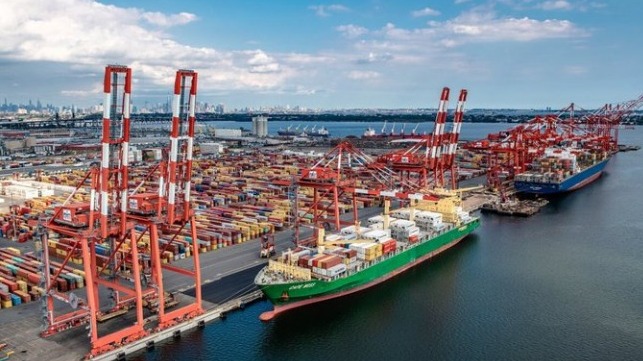Rewriting Shipping & Logistics With Technology to Boost Utilization

Capacity utilization and lack of transparency are major challenges for ocean carriers and truckers alike, and that comes at a cost to both consumers and the environment. New transparent marketplaces powered by advanced technology from the capital markets could pave the way for greater efficiency and much needed digital transformation.
When it comes to ocean shipping containers, there is often a mismatch between ship capacity and available cargo. A relatively straightforward supply and demand issue has become an industry-wide nuisance, resulting in lost revenue, unpredictable costs and unnecessary emissions. Goods end up being delayed, companies are forced to carry extra inventory, and entire supply chains are affected. Service failures like these should incur a penalty, but the current nature of the business makes it difficult to enforce contracts. These problems tend to worsen during disruptions, which can cause equipment dislocation and a build-up in cargo sitting idle, causing distress to the entire supply chain.
Similarly, the trucking industry is striving to cut down on the number of empty trucks or “deadhead miles”, which occurs when a trucker drives an empty trailer during the trip to pick up a load. Another issue is partially loaded trucks that do not utilize all the available cargo carrying capacity. Ultimately, non-optimal capacity utilization takes a toll on the economy. It creates unnecessary costs for the entire supply chain while contributing to environmental waste.
The use of emerging technologies and solutions traditionally used by the capital markets can help to address these problems by eliminating manual processes, streamlining operations, adding a layer of trust, improving transparency and providing the ability to share data more securely. In trucking, several digital freight matching platforms are available. Machine learning algorithms are also gaining traction to match trucks to shipments and automatically evaluate billions of load combinations to determine the ideal way to combine shipments.
There are several online platforms in the ocean container segment as well. However, since carriers are using multiple platforms and spreading their shipping volumes across platforms, shippers cannot get a clear and holistic view of availability and pricing as they have to go into several booking platforms to get the best price. Moreover, most of the existing booking platforms allow shippers to book online and perhaps handle invoicing, but they cannot track the entire transaction lifecycle from price discovery to final settlement. The lack of a solution that covers the full lifecycle exacerbates the utilization and transparency challenges for the industry.
Further to this, the COVID-19 pandemic is having a huge impact on trade, and it has added another layer of complexity when it comes to utilization. Personal consumption has declined overall, and consumers across the globe are buying domestically produced goods and having them shipped directly to their home. In the U.S., long haul trips have decreased while local trips under 100 miles have increased by more than 100%, according to research. Ultimately, the shipping and logistics industry has had to adjust to this new reality when businesses are already struggling with time-consuming manual processes and non-optimal utilization rates.
There are many solutions and technologies that the shipping and logistics industry can borrow from the capital markets to solve supply and demand challenges and optimize the supply chain. Marketplace technology is one of them. The most commonly used solutions by shippers generally focus on the supply side of a market – where a shipper asks for a service and is quoted a price. But marketplaces can also bring in the demand side of the equation – where shippers bid for a service by stating the amount they want to pay. This could be a long-awaited disruptive force in the industry.
Shipping marketplaces can aggregate capacity supply and demand, as well as standardize and disseminate market data. As a result, buyers and sellers can participate in price discovery and execute transactions efficiently, which saves time, reduces costs and contributes to sustainability. They can negotiate contracts as equal participants on a transparent market and enjoy a guarantee that all parties comply with agreed terms. Time-consuming manual processes can be eliminated, capacity forecasting can be improved, and overbooking on ocean vessels and running empty trucks can be reduced significantly. Carriers can benefit by boosting revenues, lowering costs and achieving sustainability goals. By ensuring data integrity, the whole supply chain can benefit from greater visibility, transparency and predictability, allowing stakeholders to improve customer service and forecast costs, revenues and time spent on the shipping process.
Technology solutions commonly used in the capital markets can help to streamline and optimize shipping and logistics workflows. Businesses can electronically execute standardized transactions and more sophisticated ones that include renegotiations of transactions, auctions and RFQs. Various data sets across industries, machine learning capabilities and analytics tools can be integrated to better predict future price fluctuations. Blockchain-based solutions can significantly reduce the paper trail and time spent on administrative tasks for supply chain stakeholders while protecting the transactions and decisions on an immutable blockchain.
There is tremendous potential to transform, disrupt and futureproof the shipping and logistics industry, as well as identify new growth opportunities using market mechanisms that allow for real-time negotiation on price. Ultimately, new shipping marketplaces can be structured in several ways. Tapping the best practices, tools and technologies used in other industries, including the capital markets, can help to solve the transparency and capacity challenges endemic in shipping and logistics, increase revenue and reduce costs.
Hanne Johansson is Head of Shipping & Logistics, Market Technology and Ben Haaland is Business Development Manager for New Markets, Market Technology at Nasdaq.
The opinions expressed herein are the author's and not necessarily those of The Maritime Executive.

